Ever been curious about the cost of connecting two software systems via an API (application programming interface)? Whether you’re linking a payment gateway to your app, syncing a CRM with marketing tools, or connecting logistics to your e-commerce site, API integration is the invisible engine powering smooth digital experiences.
However, the word “integration” may sound simple, but the price behind it is not always easy to understand.
From the kind of API you’re integrating to the level of complexity in your existing system architecture, there are a lot of moving parts that affect how long it will take, how much you’ll have to spend, and how much effort you’ll need to put in to make everything run seamlessly.
By the time you’ve finished reading, you’ll know how much it costs to build that API into your product, and you won’t have to repeat this process for your next feature. Whether you are building a startup, figuring out how to build your project, tech product manager, or tech junkie figuring out your next move, you will have a solid handle on the true cost of API integration, and what savvy decisions to make regarding your project.
What Is API Integration?
Have you ever wondered how your favourite apps send information so freely, kind of like the way your fitness tracker connects to your phone, and how your CRM connects with your email platform? The trick is API integration.
API integration is the method of using APIs to plug two or more software applications together, meaning they can share data, services, and functionality. It’s what keeps modern digital ecosystems afloat — enabling apps and platforms to function together without human involvement.
More simply speaking, APIs are kind of like digital messengers that enable programs or applications to “communicate” with each other, even if they have been created using different technologies.
Major Advantages of API Integration:
- Data sync in real time – Information can immediately sync across systems without any delay.
- Workflow automation — Automate actions across systems without manual intervention (e.g., when the order is placed, send an invoice).
- Boost productivity – Minimize human mistakes and repetitive tasks.
- Improved User Experience – Provide smooth functionality such as integrated payment gateways, chatbots, and personalized offers.
- That API mentality – Quickly integrate new apps into your tech stack.
- Agility – Operates on on-premise, cloud, and hybrid landscape.
Types Of API Integration Patterns
APIs are flexible by nature—that’s why they can accommodate any number of use-case scenarios, in many different industries. When integrating internal or external tools, learn these 6 API integration patterns so you can create better solutions.
Here are the most common API integration methodologies, which are best-fit to different business requirements:
1. B2B API Integrations
These can be direct connections between two organizations that permit data or systems to communicate in either direction.
Example Use Case: A third-party logistics provider communicating real-time shipping updates to an e-commerce platform.
2. Batch Data Processing
The data between systems is transferred periodically (manually or scheduled) using APIs in large volumes.
Example Use Case: Uploading the daily point of sale (POS) sales reports to a cloud-based analytics dashboard.
3. Business Process Automation
This one is a bit more niche: the driving force is to automate a process that touches several pieces of software. APIs allow systems to automate the process of initiating, executing, and recording workflow actions.
Use Case Example: Automatically creating an invoice in your accounting software when a new sale is logged in your CRM.
4. Automatic Synchronization Of Data
In this scenario, APIs allow data to remain mutually consistent between two or more systems, and to be synchronized in real-time or at a well-defined period.
Example Use Case: Staying in sync with customer data from Mailchimp to a CRM like Zoho.
5. Custom Integration Solutions
These are custom API setups designed to integrate with a specific way of doing business or a non-standard system configuration.
Real World Example: Integrating a legacy ERP with a modern SaaS tool using a custom-built API layer.
How Much Does It Cost to Integrate a Simple API?
The price of API integration is based on your specific needs. Whether you are just plugging into a basic 3rd party service or are constructing your own highly customizable, dynamic API infrastructure, the cost could be a very long way off, highly variable. Here’s a rough breakdown to help you plan your budget:
1. Basic API Integration
Estimated Cost: $2,000 – $5,000
This spectrum includes simple integrations where developers connect your app to third-party APIs (like payment gateways or email services).
Best for: Somewhat personalized projects.
Features:
- Single API connection
- Clear documentation
- Fast implementation
2. Moderate Complexity API Integration
Cost: $5,000 to $15,000 average
You belong to this bracket if your project requires linking an array of APIs, syncing with in-house systems, or converting data from and to platforms.
Best for: Companies automating workflows or integrating multiple SaaS tools.
Cost considerations: Custom logic, testing, security, and additional endpoints.
3. Advanced or Customized API Integration
Price Guide: $15,000 – $30,000+
For enterprise-grade projects needing completely custom APIs, complex server-side logic, and an authentication layer or 3rd party system integration.
Best for: fintech, health tech, or large platforms managing sensitive or high-volume data.
Team: Backend developers, API architects, QA testers, DevOps.
Factors Affecting the Cost Of API Integration
When estimating the cost of API integration, it’s important to look beyond just the base API development time. Several technical and architectural variables influence the overall budget—some obvious, others more hidden. Here’s a breakdown of the top factors that shape how much your API integration might cost:
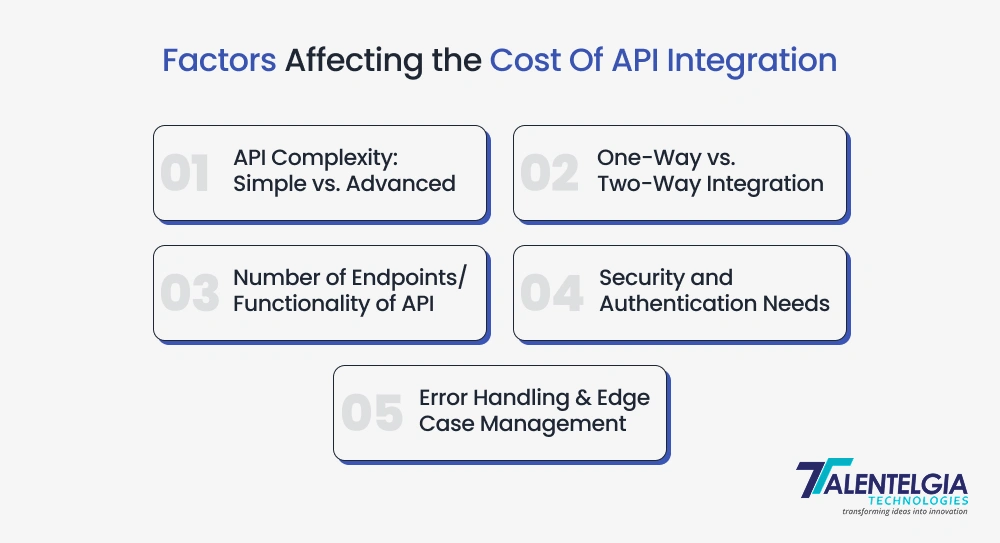
1. API Complexity: Simple vs. Advanced
All APIs are not created equal, and the tiers of complexity can seriously affect the cost of integration in general. If the API is requesting basic information (e.g., username, email), you have a simpler, less complex integration.
But, then it gets complicated if your integration has to handle nested data structures, multiple endpoints, or business logic that depends on conditions. An undocumented API slows down development, requiring greater trial, error, and guessing. On the other hand, clear and detailed documentation accelerates the process while keeping costs in check.
2. One-Way vs. Two-Way Integration
The flow of data matters much more than most people know.
- One-way API integration is when you send data from one platform to another, like capturing form submissions and pushing them to your CRM. It’s easier and faster, and less resource-intensive.
- Bi-directional data sync (two-way integration), on the other hand, ensures that both systems are synchronized in real time. And it needs conflict resolution protocols and logic for dealing with conflicts, adding development complexity and cost.
Real-time sync, in particular, is costly compared to scheduled updates, as it requires more solid infrastructure and more frequent API requests.
3. No of EndPoints/Functionality of API
The more systems or features you are integrating, the more complicated (and expensive) your integration is going to be. For example, A simple integration that takes orders from an e-commerce site and sends them to a shipping app, for instance, is quite inexpensive.
But if you also need to sync customer data, inventory, billing info, and delivery status, your endpoints and functions are multiplying. Translation: That’s more coding, testing, and debugging — all of which you pay for.
4. Security and Authentication Needs
APIs process lots of data, and security is non-negotiable, particularly for sensitive or regulated data.
Adding API keys, OAuth 2.0, token-based authentication, or multi-factor authentication (MFA) can be slow and requires specialized expertise. And that number jumps even further if your API must adhere to strict regulations such as HIPAA, GDPR, or PCI DSS.
5. Error Handling & Edge Case Management
A robust API integration doesn’t just work—it knows how to handle failure.
What if the server goes down? Or is a data field missing? Or does an API response return an error?
High-quality integrations are built with error handling, retry logic, and fail-safe workflows to manage unexpected situations. These features add to the initial cost but save you from future breakdowns, manual intervention, and customer frustration.
How To Reduce API Integration Costs?
API integrations are the backbone of digital ecosystems, but the costs can add up fast if not strategically planned for. Whether you’re working from a clean slate or patching together third-party services, low-cost integration is a matter of smart choices.
Here are six practical techniques for reducing API implementation costs while maintaining the level of performance and security required:
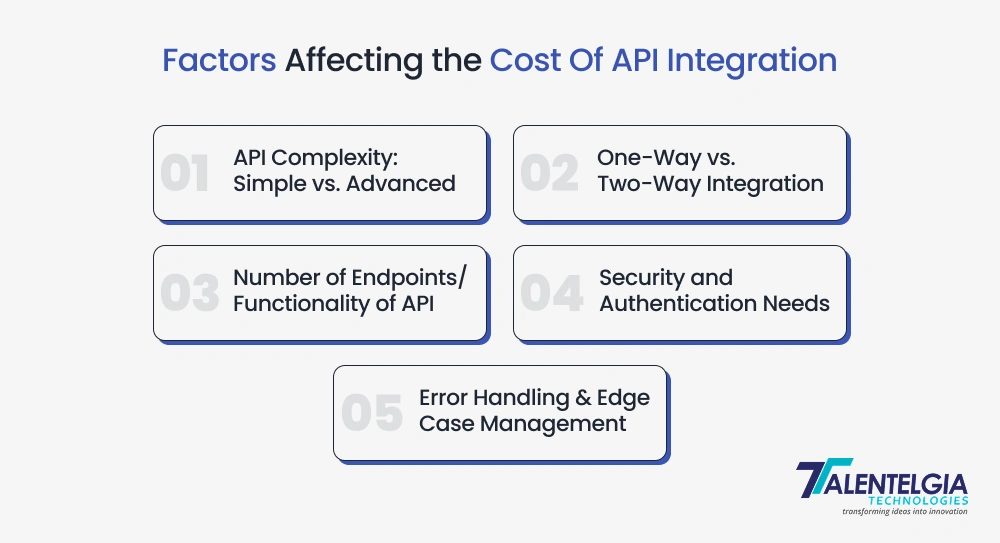
1. In-House (If You Can Build Internally)
Building API integrations in-house can drastically reduce your third-party costs, as long as your dev team has the bandwidth to do it. Although time-consuming up front, ultimately, you will have full control of architecture, used technology, security, and maintenance, while saving costs in the long run.
When to use this:
You have a talented in-house dev team and want to be in control of data flow and security.
2. Negotiate with API vendors
Don’t accept the sticker price. API providers routinely discount their services for high volumes, annual commitments, or for startups. Enter at the time the negotiations are based on well-defined usages, and stress the ongoing ‘partnership’.
3. Leverage pre-built or low-code integration platforms
You don’t have to write every integration from scratch. There are platforms like Zapier, Make (Integromat), or MuleSoft where you have these pre-built connectors that save you time and development effort — probably ideal for SMBs or those MVPs you want to ship quickly.
4. Don’t Scrimp on API Security
Data breaches are expensive. A lapse in API security can be much more costly than an integration project. Leverage rate limits, encryption, token-based authentication, and constant monitoring to secure your data and your wallet.
5. Monitor, Optimize, Repeat
Establish real-time monitoring and analytics from day one. By outsourcing a middleware solution, you can catch errors early on, which saves you support costs, downtime, and keeps your API performing at its best.
Use tools like:
New Relic, Datadog, Splunk, or API platforms’ dashboards.
6. Monitor, Optimize, Repeat
Real-time monitoring and analytics set up. By detecting issues early, you can minimize support costs, prevent downtime, and guarantee that your APIs are performing at their highest potential.
Use tools like:
New Relic, Datadog, Splunk, or out-of-the-box dashboards within API platforms.
Real-World API Integration Cost Breakdown
The costs of integration will differ significantly according to both the complexity of your configuration and the type of system you’re connecting. Here’s a grounded look at what different types of integration could cost based on real market trends:
1. Integration With The E-commerce Platform
You should expect to spend between $15,000 – $30,000 per eCommerce platform integration. Internal costs — If you’re managing multiple platforms internally, fees can rise annually to $90,000 or more. Hourly rates of development also differ by location:
Eastern Europe: $20–$50/hr
Central Europe: $30–$70/hr
Northern Europe: $50–$120/hr
Western Europe: $60–$150/hr
2. CRM Integration
Adapting a CRM, old or new, poses a $20,000 to $40,000 price tag, all dependent on complexity. Less complex integrations can cost as little as $6,000, but older systems typically require a higher price of custom development. Add in Face ID development costs, developers in most Silicon Valley hubs get paid up to $150,000 per year ($72/hr), it adds up quickly.
3. Payment Gateway Integration
The initial integration points for a payment gateway typically start at $10,000 and can exceed $25,000—plus it doesn’t end there! Payment processors usually charge 2.9% + $0.30 per transaction, plus possible additional fees for:
- Cross-border payments: +1%
- Chargebacks: $15–$20 per case
- Gateway fees: Approximately $25 per month
- Merchant account set-up: $49 or less
If you are developing your own gateway, the price can range from $150,000 to $800,000. That’s development as well as maintenance, API documentation, infrastructure, PCI DSS compliance, and security certifications like SSL.
Quick Read: Gemini API Costs: Factors, Benefits, and How to Use It?
Email API Integration for Developers: Fast & Reliable
Conclusion
API integration is essential to facilitate the smooth interaction of new and old software, however, it requires planning, technical know-how, and financial resources. Apart from the technical implementation, the real benefit of API integration is the long-term scalability and business agility. By treating it as a strategic long-term effort rather than a one-off project, organisations can be confident they are laying down a solid base for future digital innovation.


 Healthcare App Development Services
Healthcare App Development Services
 Real Estate Web Development Services
Real Estate Web Development Services
 E-Commerce App Development Services
E-Commerce App Development Services E-Commerce Web Development Services
E-Commerce Web Development Services Blockchain E-commerce Development Company
Blockchain E-commerce Development Company
 Fintech App Development Services
Fintech App Development Services Fintech Web Development
Fintech Web Development Blockchain Fintech Development Company
Blockchain Fintech Development Company
 E-Learning App Development Services
E-Learning App Development Services
 Restaurant App Development Company
Restaurant App Development Company
 Mobile Game Development Company
Mobile Game Development Company
 Travel App Development Company
Travel App Development Company
 Automotive Web Design
Automotive Web Design
 AI Traffic Management System
AI Traffic Management System
 AI Inventory Management Software
AI Inventory Management Software
 AI Software Development
AI Software Development  AI Development Company
AI Development Company  AI App Development Services
AI App Development Services  ChatGPT integration services
ChatGPT integration services  AI Integration Services
AI Integration Services  Generative AI Development Services
Generative AI Development Services  Natural Language Processing Company
Natural Language Processing Company Machine Learning Development
Machine Learning Development  Machine learning consulting services
Machine learning consulting services  Blockchain Development
Blockchain Development  Blockchain Software Development
Blockchain Software Development  Smart Contract Development Company
Smart Contract Development Company  NFT Marketplace Development Services
NFT Marketplace Development Services  Asset Tokenization Company
Asset Tokenization Company DeFi Wallet Development Company
DeFi Wallet Development Company Mobile App Development
Mobile App Development  IOS App Development
IOS App Development  Android App Development
Android App Development  Cross-Platform App Development
Cross-Platform App Development  Augmented Reality (AR) App Development
Augmented Reality (AR) App Development  Virtual Reality (VR) App Development
Virtual Reality (VR) App Development  Web App Development
Web App Development  SaaS App Development
SaaS App Development Flutter
Flutter  React Native
React Native  Swift (IOS)
Swift (IOS)  Kotlin (Android)
Kotlin (Android)  Mean Stack Development
Mean Stack Development  AngularJS Development
AngularJS Development  MongoDB Development
MongoDB Development  Nodejs Development
Nodejs Development  Database Development
Database Development Ruby on Rails Development
Ruby on Rails Development Expressjs Development
Expressjs Development  Full Stack Development
Full Stack Development  Web Development Services
Web Development Services  Laravel Development
Laravel Development  LAMP Development
LAMP Development  Custom PHP Development
Custom PHP Development  .Net Development
.Net Development  User Experience Design Services
User Experience Design Services  User Interface Design Services
User Interface Design Services  Automated Testing
Automated Testing  Manual Testing
Manual Testing  Digital Marketing Services
Digital Marketing Services 
 Ride-Sharing And Taxi Services
Ride-Sharing And Taxi Services Food Delivery Services
Food Delivery Services Grocery Delivery Services
Grocery Delivery Services Transportation And Logistics
Transportation And Logistics Car Wash App
Car Wash App Home Services App
Home Services App ERP Development Services
ERP Development Services CMS Development Services
CMS Development Services LMS Development
LMS Development CRM Development
CRM Development DevOps Development Services
DevOps Development Services AI Business Solutions
AI Business Solutions AI Cloud Solutions
AI Cloud Solutions AI Chatbot Development
AI Chatbot Development API Development
API Development Blockchain Product Development
Blockchain Product Development Cryptocurrency Wallet Development
Cryptocurrency Wallet Development About Talentelgia
About Talentelgia  Our Team
Our Team  Our Culture
Our Culture 
 Healthcare App Development Services
Healthcare App Development Services Real Estate Web Development Services
Real Estate Web Development Services E-Commerce App Development Services
E-Commerce App Development Services E-Commerce Web Development Services
E-Commerce Web Development Services Blockchain E-commerce
Development Company
Blockchain E-commerce
Development Company Fintech App Development Services
Fintech App Development Services Finance Web Development
Finance Web Development Blockchain Fintech
Development Company
Blockchain Fintech
Development Company E-Learning App Development Services
E-Learning App Development Services Restaurant App Development Company
Restaurant App Development Company Mobile Game Development Company
Mobile Game Development Company Travel App Development Company
Travel App Development Company Automotive Web Design
Automotive Web Design AI Traffic Management System
AI Traffic Management System AI Inventory Management Software
AI Inventory Management Software AI Software Development
AI Software Development AI Development Company
AI Development Company ChatGPT integration services
ChatGPT integration services AI Integration Services
AI Integration Services Machine Learning Development
Machine Learning Development Machine learning consulting services
Machine learning consulting services Blockchain Development
Blockchain Development Blockchain Software Development
Blockchain Software Development Smart contract development company
Smart contract development company NFT marketplace development services
NFT marketplace development services IOS App Development
IOS App Development Android App Development
Android App Development Cross-Platform App Development
Cross-Platform App Development Augmented Reality (AR) App
Development
Augmented Reality (AR) App
Development Virtual Reality (VR) App Development
Virtual Reality (VR) App Development Web App Development
Web App Development Flutter
Flutter React
Native
React
Native Swift
(IOS)
Swift
(IOS) Kotlin (Android)
Kotlin (Android) MEAN Stack Development
MEAN Stack Development AngularJS Development
AngularJS Development MongoDB Development
MongoDB Development Nodejs Development
Nodejs Development Database development services
Database development services Ruby on Rails Development services
Ruby on Rails Development services Expressjs Development
Expressjs Development Full Stack Development
Full Stack Development Web Development Services
Web Development Services Laravel Development
Laravel Development LAMP
Development
LAMP
Development Custom PHP Development
Custom PHP Development User Experience Design Services
User Experience Design Services User Interface Design Services
User Interface Design Services Automated Testing
Automated Testing Manual
Testing
Manual
Testing About Talentelgia
About Talentelgia Our Team
Our Team Our Culture
Our Culture
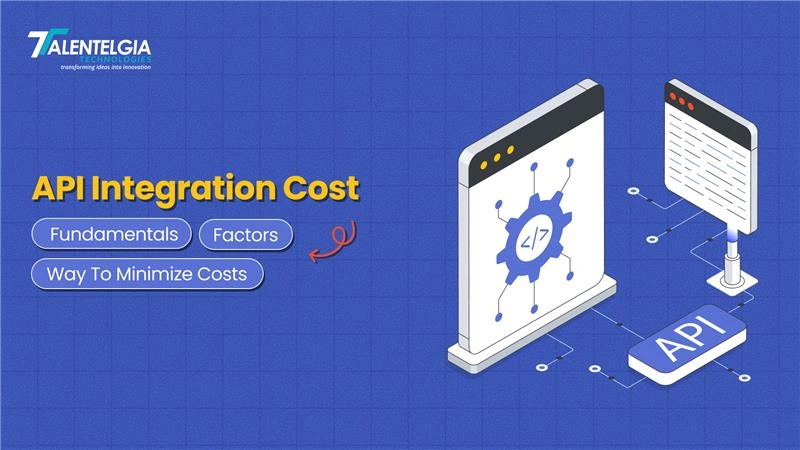

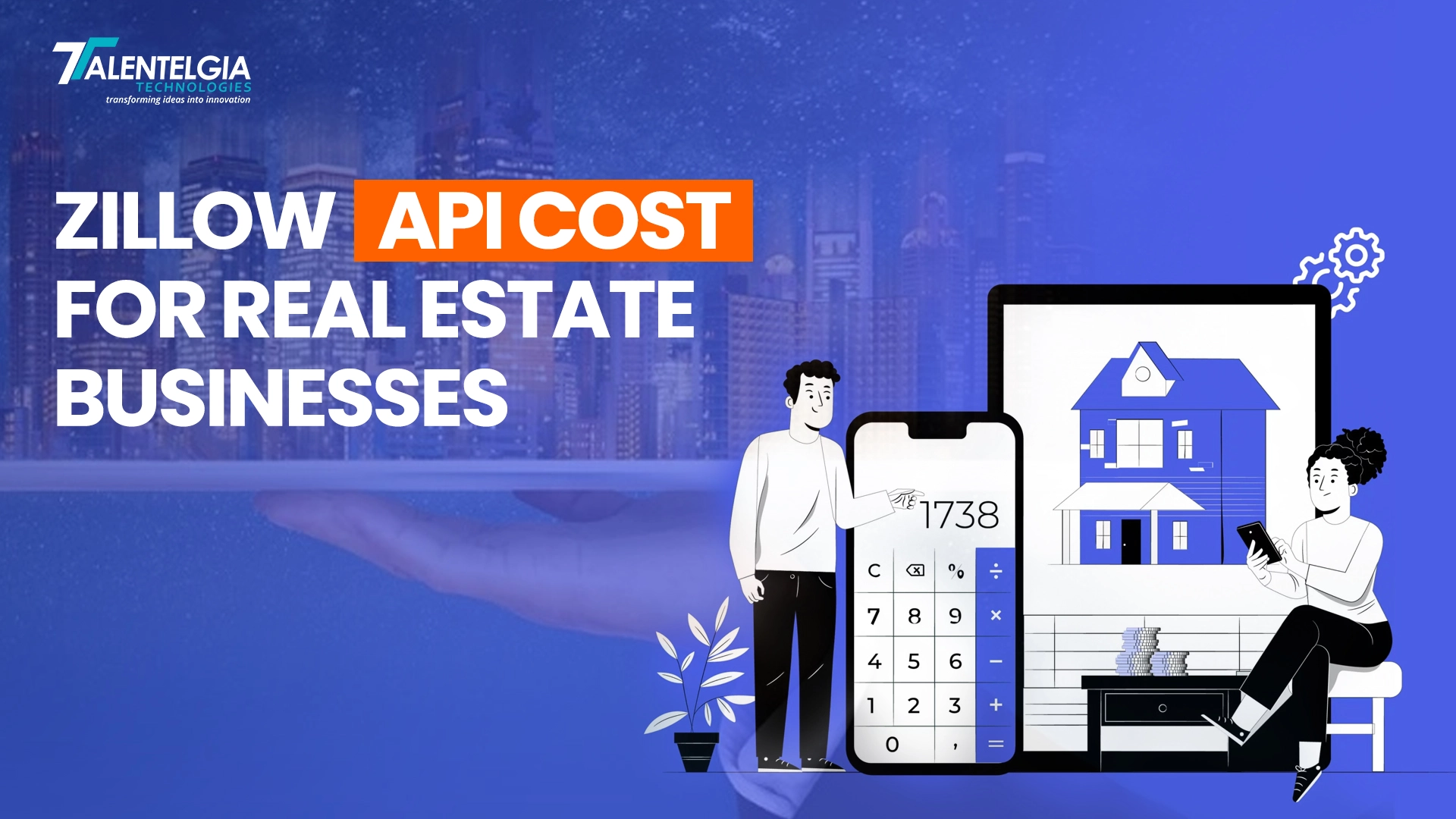

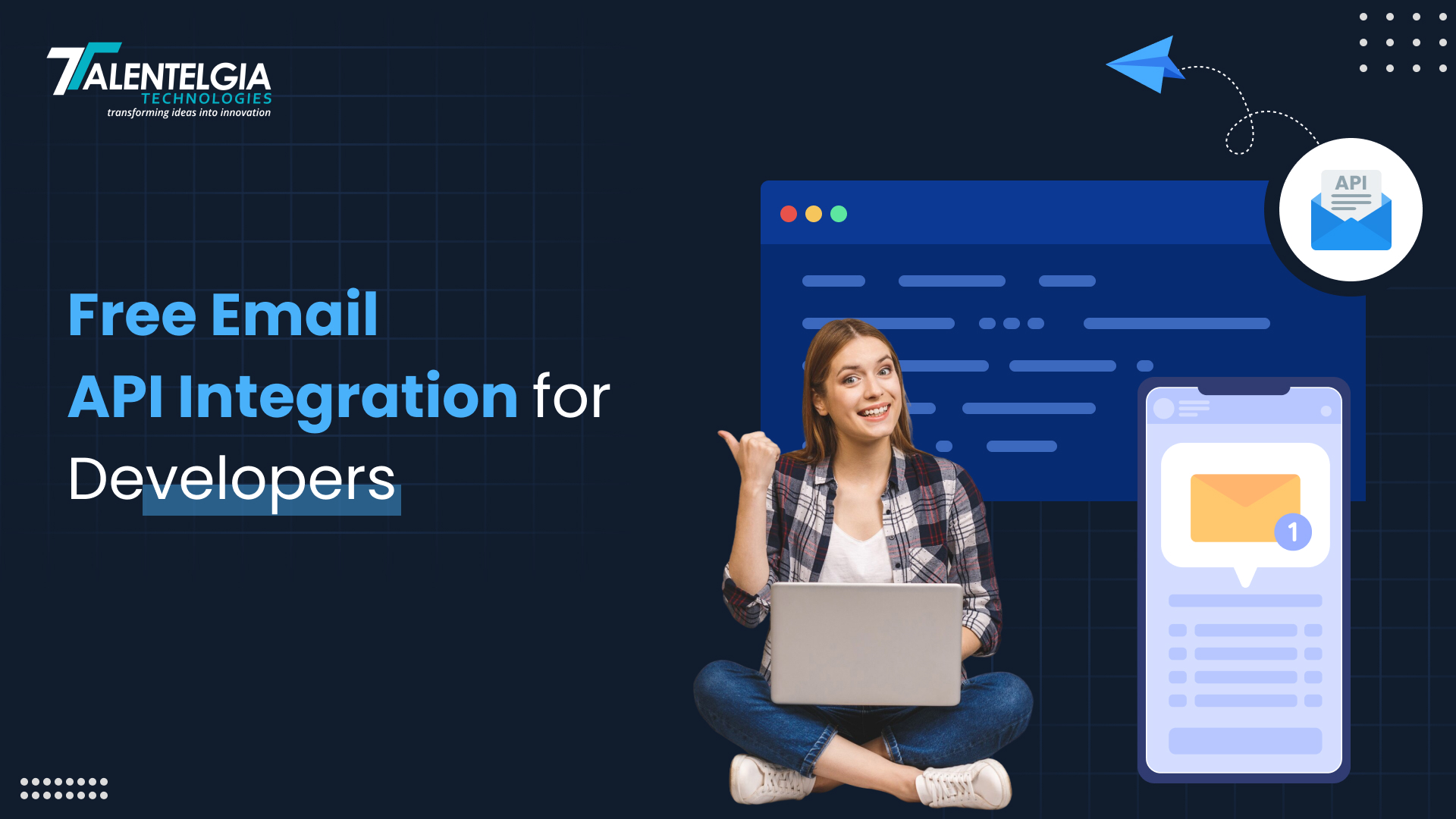











 Write us on:
Write us on:  Business queries:
Business queries:  HR:
HR: 




